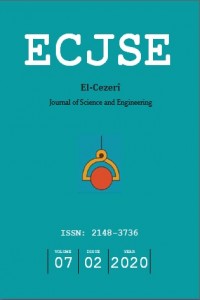Öz
Bu çalışmada, koaksiyel rotorlar için itki, tork ve güç kavramları farklı kanat sayısına ve rotor mesafesine göre incelenmiştir. Bu araştırma için koaksiyel rotorlar üzerindeki üç boyutlu (3B) akışın hesaplamalı akışkanlar dinamiği (HAD) analizi kullanılmıştır. Güç ve tork kavramları, uçak ve kanat profili tasarımı için önemli bir parametredir. İtki, uçak performansı için başka bir kritik parametredir. Bir rotor, dönme hareketini itkiye dönüştürerek gücü aktaran bir fan türüdür. Kanat profili şeklindeki kanadın ön ve arka yüzeyleri arasında bir basınç farkı üretilir. Bu basınç farkı bir itki üretir. Her rotor kanadı, itki ve sürükleme üreten döner bir kanattır. İtki parametresi, kanat sayısı ile doğrudan orantılıdır. Kanat sayısı artarsa, itkide artar. Rotorun kanat sayısı arttıkça, rotor tarafından üretilen tork ve rotoru çalıştırmak için gereken güç de artacaktır. Bu çalışmada kanat sayısının (2, 3 ve 4 kanat) ve rotorlar arasındaki mesafenin (0,05 * D, 0,1 * D, 0,25 * D, 0,5 * D, 0,75 * D, 1 * D) itkiye, torka ve güce etkisi incelenmiştir.
Kaynakça
- [1] The Wikipedia website. [Online]. Available: https://en.wikipedia.org/wiki/Propeller, 2016.
- [2] Noh M. H. M.; Rashid H.; Hamid A. H. A.; Iskandar M. F, Comparison of Numerical Investigation on Airfoil and Flat Louvers on the Air Duct Intake, Procedia Engineering, 2012, 41, 1761 – 1768.
- [3] Fang-Wen H.; Shi-Tang D., Numerical Analysis for Circulation Distribution of Propeller Blade, Journal of hydrodynamics, 2010, 22(4): 488-493.
- [4] Ueno M.; Tsukada Y., Estimation of full-scale propeller torque and thrust using free-running model ship in waves, Ocean Engineering, 2016, 120, 30–39.
- [5] Driss Z.; Mlayeh O.; Driss D.; Maaloul M.; Abid M. S., Numerical simulation and experimental validation of the turbulent flow around a small incurved Savonius wind rotor, Energy, 2014, 74, 506-517.
- [6] Doğru M. H.; Güzelbey İ. H.; Göv İ., Ducted Fan Effect on the Elevation of a Concept Helicopter When the Ducted Faintail is Located in a Ground Effect Region, Journal of Aerospace Engineering, 2016, 29(1), 04015030.
- [7] Lei Y.; Bai Y.; Xu Z.; Gao Q.; Zhao C., An experimental investigation on aerodynamic performance of a coaxial rotor system with different rotor spacing and wind speed, Experimental Thermal and Fluid Science, 2013, 44, 779–785.
- [8] Göv İ., Blade Number Effect on the Thrust, Torque and Power of Propeller, International Conference on Advanced Technology & Sciences, 2016, 1435-1438.
- [9] The airfoiltools website. [Online]. Available: http://airfoiltools. Com /airfoil /details? airfoil= naca4415-il, 2016.
Öz
In this study, thrust, torque and power concepts are investigated according to different blade number and rotor spacing for coaxial rotors. The computational fluid dynamic (CFD) analysis of three-dimensional (3D) flow over coaxial rotors is used for this investigation. Power and torque concepts are the important parameter for the design of aircraft and airfoil. Thrust is also another critical parameter for the aircraft performance. A rotor is a type of fan that transmits power by converting rotational motion into thrust. A pressure difference is produced between the forward and rear surfaces of the airfoil-shaped blade. This pressure difference produce a thrust. Each rotor blade is a rotating airfoil, which produces thrust and drag. Thrust parameter is directly proportionate with blade number. If the blade number increase, thrust will increase. If the blade number of rotor increase, the produced torque by rotor and the needed power to drive rotor will also increase. In this study, the effect of blade number (2, 3 and 4 blades) and distance between rotors (0.05*D, 0.1*D, 0.25*D, 0.5*D, 0.75*D, 1*D) on the thrust, torque and power is investigated.
Kaynakça
- [1] The Wikipedia website. [Online]. Available: https://en.wikipedia.org/wiki/Propeller, 2016.
- [2] Noh M. H. M.; Rashid H.; Hamid A. H. A.; Iskandar M. F, Comparison of Numerical Investigation on Airfoil and Flat Louvers on the Air Duct Intake, Procedia Engineering, 2012, 41, 1761 – 1768.
- [3] Fang-Wen H.; Shi-Tang D., Numerical Analysis for Circulation Distribution of Propeller Blade, Journal of hydrodynamics, 2010, 22(4): 488-493.
- [4] Ueno M.; Tsukada Y., Estimation of full-scale propeller torque and thrust using free-running model ship in waves, Ocean Engineering, 2016, 120, 30–39.
- [5] Driss Z.; Mlayeh O.; Driss D.; Maaloul M.; Abid M. S., Numerical simulation and experimental validation of the turbulent flow around a small incurved Savonius wind rotor, Energy, 2014, 74, 506-517.
- [6] Doğru M. H.; Güzelbey İ. H.; Göv İ., Ducted Fan Effect on the Elevation of a Concept Helicopter When the Ducted Faintail is Located in a Ground Effect Region, Journal of Aerospace Engineering, 2016, 29(1), 04015030.
- [7] Lei Y.; Bai Y.; Xu Z.; Gao Q.; Zhao C., An experimental investigation on aerodynamic performance of a coaxial rotor system with different rotor spacing and wind speed, Experimental Thermal and Fluid Science, 2013, 44, 779–785.
- [8] Göv İ., Blade Number Effect on the Thrust, Torque and Power of Propeller, International Conference on Advanced Technology & Sciences, 2016, 1435-1438.
- [9] The airfoiltools website. [Online]. Available: http://airfoiltools. Com /airfoil /details? airfoil= naca4415-il, 2016.
Ayrıntılar
| Birincil Dil | İngilizce |
|---|---|
| Konular | Mühendislik |
| Bölüm | Makaleler |
| Yazarlar | |
| Yayımlanma Tarihi | 31 Mayıs 2020 |
| Gönderilme Tarihi | 16 Aralık 2019 |
| Kabul Tarihi | 27 Şubat 2020 |
| Yayımlandığı Sayı | Yıl 2020 Cilt: 7 Sayı: 2 |
Açık Dergi Erişimi (BOAI)
Bu eser Creative Commons Atıf-GayriTicari 4.0 Uluslararası Lisansı ile lisanslanmıştır.






